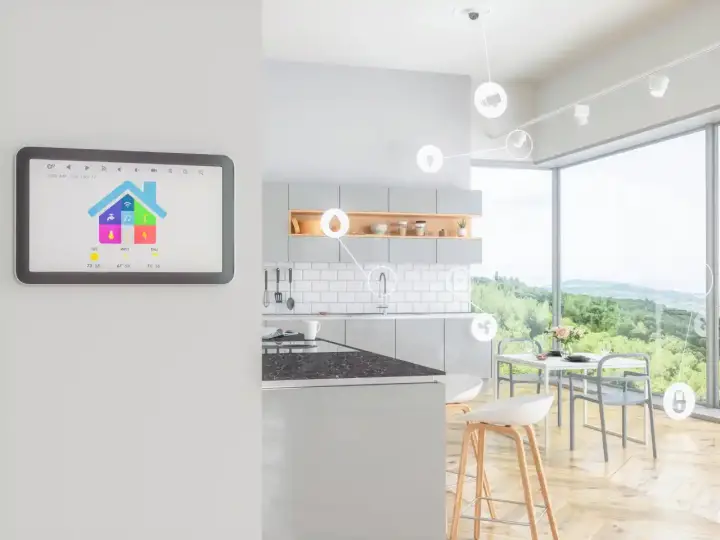3 Awesome Ways to Keep Your Home's Windows Safe With Z-Wave
Updated on 13th Feb 2021 17:39 in General, Smart
The idea that your house could be broken into is never something anyone wants to consider. Unfortunately, these things can happen, and the only realistic way to prevent severe damage is to have an alarm system in place. Many homeowners deal with a common problem with the presence of a large window on the ground level, which is almost an invitation for someone to break in. While breaking windows may not be the ideal entry method, it's still common and could result in all your valuables being stolen. A glass break sensor is often used to detect this situation and sound an alarm that will alert everyone while also calling for help in some cases. Let's see how these can be used with Z-Wave along with whether you should use them at all.

Disclaimer: This post contains affiliate links. As an Amazon Associate, I earn from qualifying purchases.
Table of Contents
Glass break sensor
The idea is quite nice. A sensor placed in a room will detect the sound of glass breaking, allowing a single device to cover all the windows at once. Unfortunately, like most things, this is too good to be true. Users everywhere report that anything from loud noises to dropping your keys on the ground can cause your glass break sensor to trigger. This problem is compounded by the fact that pets like dogs can cause the alarm to go off just by barking or doing other standard pet stuff. Many products claim to be resilient to such false positives, but many users disagree, arguing that while they trigger less often, they still incorrectly detect common sounds.
If you think about it, there is some logic in the idea that such a detection device would be quite difficult to make. The sound of glass breaking isn't really that unique and can be recreated in several ways, especially if there is a lot of ambient noise in the room. You would need a decent amount of processing power to classify different sounds accurately, which is usually going to increase the product's cost a lot. As a result, most cheap glass break sensors are actually using a microphone tuned to pick up the frequencies emitted when glass breaks. The problem is that many things can emit the same frequency, which confuses the sensor and results in a false positive.
In any case, their ability to accurately detect the sound of glass breaking is contested, and you can almost be sure that the cheap devices will not work correctly. A loud noise is all many of them need to trip! All of these issues are probably why it's so difficult to find a Z-Wave compatible glass break sensor. In fact, while researching this topic, I could only find a single product that is still being sold. It's called the GoControl Smart Glass Break Detector, and its accuracy is also up in the air. Buy this at your own risk as there is a good chance it won't work properly if your home is too noisy. If you have pets, I would recommend you pass on this type of sensor as they can often cause false positives.
Shock/Vibration sensor
For a reason, most likely related to marketing, these are often impossible to separate from the previously mentioned acoustic sensors. They usually go under the name "glass break sensor" despite being totally different in operation. Unlike the previous kind, these must be placed directly on the glass's surface so they can detect the vibrations caused by breaking the window. The detection is done mechanically, meaning even the quietest burglars will be caught when the tension in the glass breaks, causing vibrations to ripple through the surface. Some detect tiny acceleration changes while others are designed to be "shock" sensors and have a much higher threshold.
Unfortunately, this mechanism means that you will need one for each window unless you can confirm that hitting one will cause significant vibration in the others. Finding these can also be a bit tricky despite being much easier than the previous kind. They are most often found in "multisensors" where they are included for tamper detection. The chance of a false positive is much smaller than the acoustic sensor as the glass needs to physically move before anything happens. Knocking on the glass will likely trigger the alarm, which could be a problem if you have a pet that likes to jump against windows. In most cases, Z-Wave versions will be sold as vibration sensors rather than anything related to glass.
Aeotec Multisensor 6
The Aeotec Multisensor 6 is a Z-Wave multisensor that combines 6 sensors into one unit. In addition to the vibration detector, the device can also measure temperature, humidity, light, and UV. It's pretty small and isn't necessarily designed for use on windows, but you can certainly mount it nearby to get goods coverage. The best feature is the builtin motion sensor that can be used as a second level of certainty that someone did enter your home. Considering that one of these cost the same as a bunch of the dedicated Z-Wave products, you are getting some serious value with all these sensors combined!
Check out the Aeotec Multisensor 6 on Amazon!
Motion sensors
Anyone that's had an alarm system installed in the last few years will know that they tend to use motion sensors and contact sensors almost exclusively. There are a few reasons for this, one of which is that it's easier to keep two products in stock than a whole bunch of different ones. Another one is that they work really well and are much better at only triggering when a person moves. Contact sensors are basically king when it comes to detecting that a door or window was opened. They rely on the physical separation of their two components to trigger, making false positives highly unlikely. Read more about contact sensors and their uses in my article on the subject here!
Motion sensors are extremely useful for identifying a burglar simply because they detect the difference in Infrared (IR) energy between the background and a moving person or animal. A properly configured motion sensor will identify living beings moving every time, with their biggest flaw being that a dog or other animal could result in detectable motion. That's because the IR energy is effectively just heat, so hot things that move can trigger these sensors. Luckily, in ordinary life, there aren't too many things hotter than the environment that can move and that aren't alive. Many systems can also be configured to reject small differences in IR energy, causing them to ignore motion caused by pets.
You may wonder how a motion sensor could be used to replace a glass break sensor, and the answer is quite simple. A motion sensor pointed at a window will trigger any time movement occurs around it and can even identify someone on the other side of the glass in some cases! Some glass blocks IR light at varying temperatures though, so this functionality is not expected normally. That's not a bad thing though, as now the system will only trigger the alarm if a movement is detected inside the house rather than outside. The first product to mention is the Aeotec Multisensor again as it also contains a built-in motion sensor, perfect for guarding windows. We will also look at another sensor that is visually a lot more like what most security systems use.
Ecolink Z-Wave PIR Motion Detector
This motion sensor has the look and feel of a classic, dealer installed alarm system making it much easier to mount without ruining the beauty of your home. It runs on batteries specified to last up to 5 years which helps resolve the power problem often encountered with these kinds of sensors. The device is totally wireless, making installation easy in any location as you only need to worry about being within range of the Z-Wave network. There is built-in pet rejection which can reduce the number of false positives caused by pets up to 55lbs. The rejection sensitivity can be adjusted using a jumper wire on the back, which is useful if your pet is smaller or if you don't have one at all.
Check out the Ecolink Z-Wave PIR Motion Detector on Amazon!
Summary
Searching for a Z-Wave glass break sensor seems to yield next to no results and can be a frustrating experience if you are trying to find one to protect your home. The shortage suggests that other sensor types should be used instead, as there isn't enough demand to justify creating these products. Many manufacturers like Aeotec actually used to offer Z-Wave versions of these sensors but have since stopped selling it, presumably due to low sales or inadequate performance. It's hard to know the real reason no one seems to sell them anymore, but regardless, the message is clear: use something else.
Vibration sensors are much easier to find and less prone to false positives but are much harder to install than other options. To make things worse, vibration sensors most often come in large form factors that aren't practical for mounting directly against glass. In any case, the lack of options leads us to look elsewhere and see that motion sensors are probably the best bet for detecting intrusions near a window. If anyone breaks the window, they will initially be okay until they enter, where they will trigger the motion detector and set off the alarm. Coupled with their availability, motion sensors easily become my pick for detecting that your home could be in danger.





